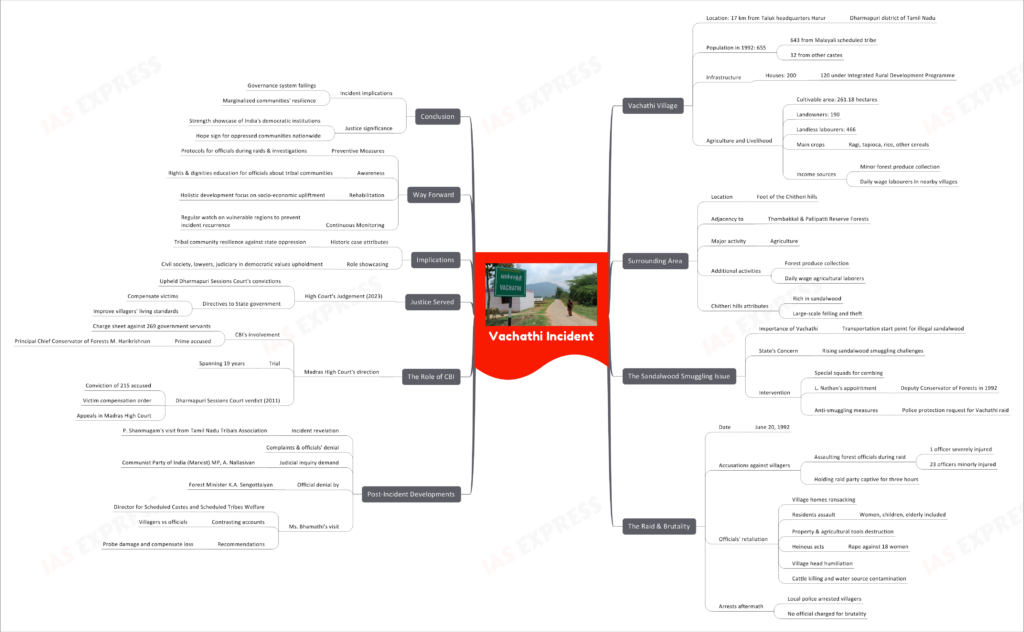Vachathi Incident- Background, Recent Verdict & its Significance
From Current Affairs Notes for UPSC » Editorials & In-depths » This topic
IAS EXPRESS Vs UPSC Prelims 2024: 85+ questions reflected
Vachathi, a tribal village in Tamil Nadu, faced a tragic incident in 1992 involving illegal sandalwood smuggling and a brutal crackdown by the state. The recent verdict from the Madras HC is being celebrated as a victory for the weak.

Background
Vachathi Village
- Location: 17 km from Taluk headquarters Harur in Dharmapuri district of Tamil Nadu.
- Population in 1992: 655
- 643 from Malayali scheduled tribe community.
- 12 from other castes.
- Infrastructure:
- Around 200 houses, 120 of which were built under the Integrated Rural Development Programme.
- Agriculture and Livelihood:
- Cultivable area: 261.18 hectares.
- Landowners: 190.
- Landless labourers: 466.
- Main crops: Ragi, tapioca, rice, and other cereals.
- Additional sources of income: Collecting minor forest produce, serving as daily wage labourers in nearby villages.
Surrounding Area
- Located at the foot of the Chitheri hills.
- Adjacent to Thombakkal and Pallipatti Reserve Forests.
- Major activity: Agriculture
- Tribals also collected forest produce and worked as daily wage agricultural laborers.
- Chitheri hills reserve forests were rich in sandalwood leading to large-scale felling and theft.
The Sandalwood Smuggling Issue
- Importance of Vachathi: Starting point for transportation of illegal sandalwood from the Chitheri hill region.
- State’s Concern: Rising sandalwood smuggling, posing challenges to the forest department.
- Intervention:
- Special squads formed for combing operations.
- L. Nathan was appointed as Deputy Conservator of Forests in 1992.
- Initiatives to stop sandalwood smuggling, including requesting police protection for a raid in Vachathi.
The Raid & Brutality
- Date: June 20, 1992.
- Accusations: Villagers were accused of assaulting forest officials during the raid.
- 1 officer severely injured.
- 23 officers minorly injured.
- Claimed villagers held raid party captive for three hours.
- After the initial raid, 269 forest, police, and revenue officials retaliated by:
- Ransacking village homes.
- Assaulting residents including women, children, and the elderly.
- Destroying property and agricultural tools.
- Committing heinous acts, including rape against 18 women.
- Forcing the village head into humiliating acts.
- Killing cattle and contaminating water sources.
- Local police arrested villagers but no officials were charged for their brutality.
Post-Incident Developments
- Brutality came to light when P. Shanmugam from Tamil Nadu Tribals Association visited Vachathi.
- Complaints lodged, but officials denied any wrongdoings.
- Demand for a judicial inquiry by Communist Party of India (Marxist) MP, A. Nallasivan.
- Initial denial by officials, including the then Forest Minister K.A. Sengottaiyan.
- Visit by the Director for Scheduled Castes and Scheduled Tribes Welfare, Ms. Bhamathi, revealed contrasting accounts from villagers and officials.
- Recommendations included probing damage and compensating for loss.
The Role of CBI
- On the Madras High Court’s order, the CBI took up the case.
- Charge sheet against 269 government servants.
- Prime accused: Principal Chief Conservator of Forests M. Harikrishnan.
- Lengthy trial spanning 19 years.
- Dharmapuri Sessions Court verdict in 2011:
- Conviction of 215 accused under various provisions.
- Compensation ordered for victims.
- Appeals made in Madras High Court.
Justice Served
High Court’s Judgement
- 2023: Madras High Court upheld Dharmapuri Sessions Court’s convictions.
- Directed State government to compensate victims and improve villagers’ living standards.
Implications
- A historic case showing the resilience of the tribal community in seeking justice against state oppression.
- Highlights the role of various institutions, including civil society, lawyers, and the judiciary, in upholding democratic values.
Way Forward
- Preventive Measures: Implement strict protocols for officials during raids and investigations.
- Awareness: Educate officials about the rights and dignities of tribal and marginalized communities.
- Rehabilitation: Ensure the holistic development of affected communities, focusing on their socio-economic upliftment.
- Continuous Monitoring: Regularly monitor such vulnerable regions to avoid a recurrence of such incidents.
Conclusion
The Vachathi incident is a stark reminder of the occasional failings of governance systems and the resilience of marginalized communities. The eventual justice served, though delayed, signifies the strength of India’s democratic institutions and offers a glimmer of hope for oppressed communities nationwide.
Practice Question for Mains
Discuss the significance of the recent verdict on Vachathi case. How can we prevent the repeat of the Vachathi incident? (250 words)
If you like this post, please share your feedback in the comments section below so that we will upload more posts like this.

